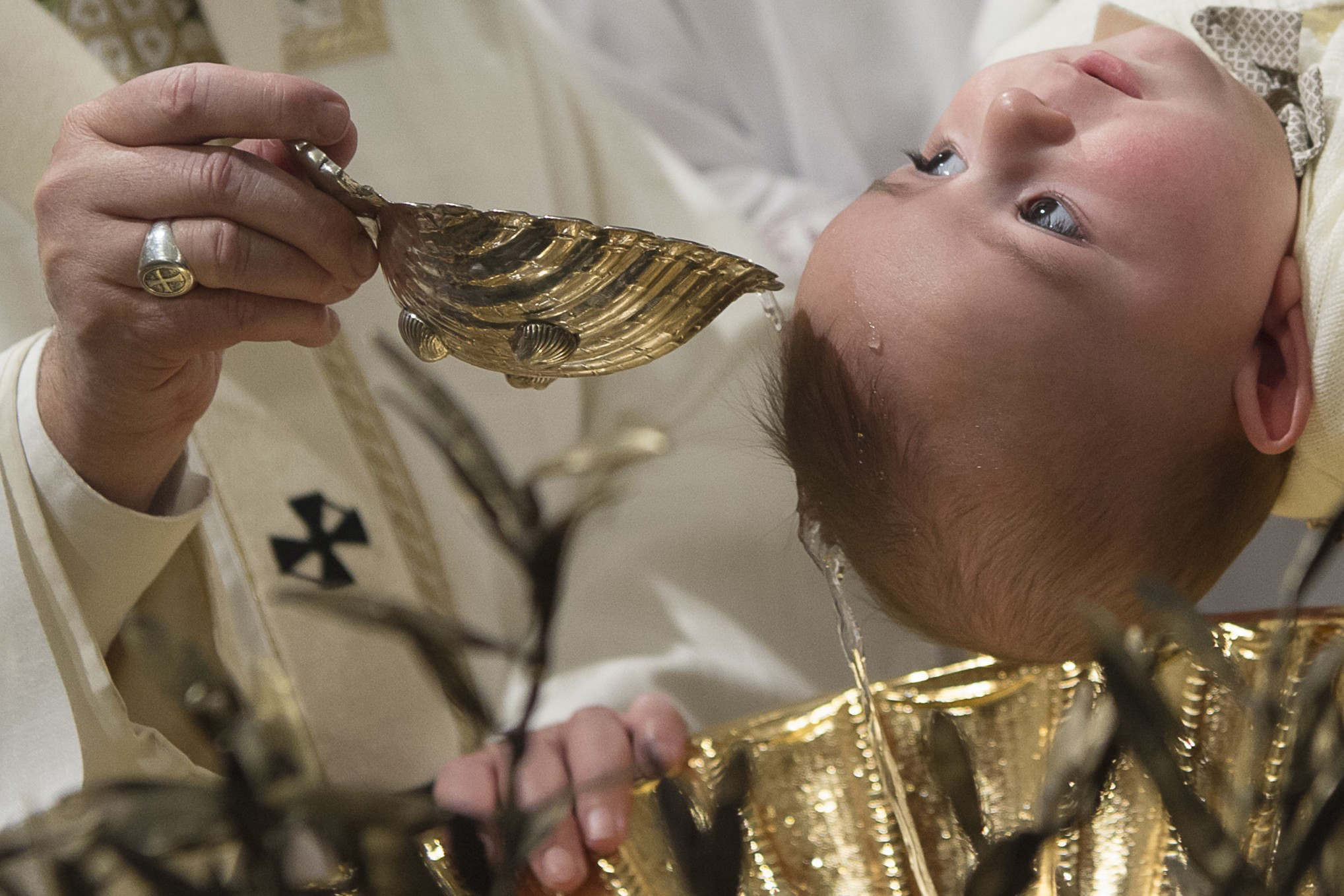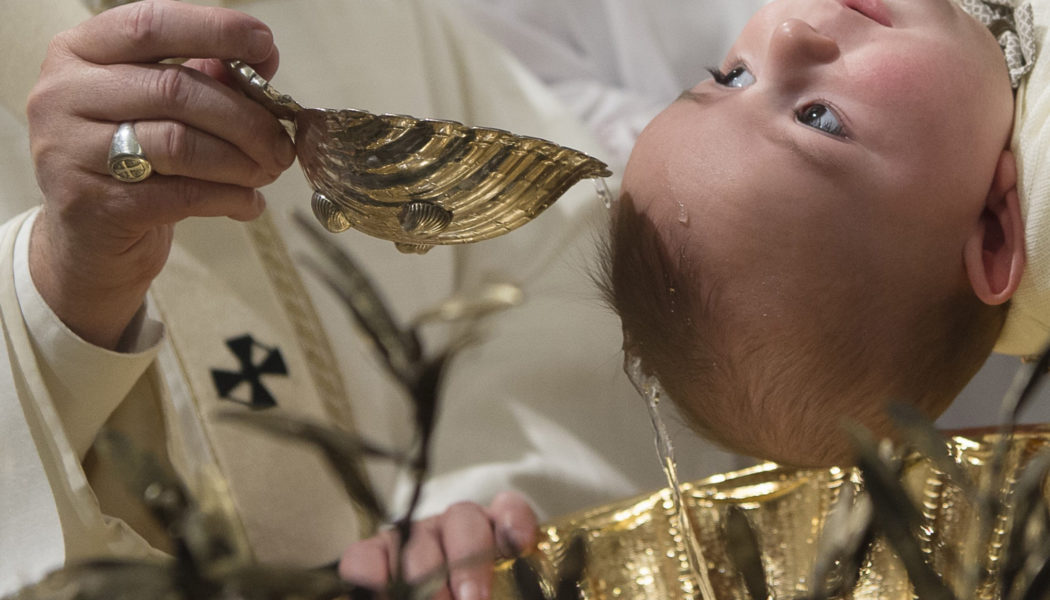
Just over a year ago on Easter 2020, a new translation of The Order of Baptism of Children replaced the translation that had been in use for around 50 years. The first edition of the Latin typical edition of the Rite of Baptism for Children was published in 1969, and many ritual editions in English were based off of that version. Some reprints of the rite also incorporated modifications from second typical edition in 1973. This second edition served as the basis for the new English translation in 2020. The new translation is a fruit, in part, of the 2001 instruction Liturgiam Authenticam that provided new and expanded guidelines for the translation of liturgical documents of the Roman liturgy.
The changes to baptism were rather modest since they reflected only a new translation rather than a new edition of the liturgical book. Compared with the translation of the Roman Missal nine years previous, the modifications to The Order of Baptism of Children went largely unnoticed. This is certainly due to the fact that the faithful hear the prayers of baptism far less frequently than they do the order of Mass. Moreover, the promulgation of the new translation during COVID-19 restrictions probably led to even fewer people hearing the newly translated prayers.
Nevertheless, it remains the case that the voice with which the Church speaks at baptism has received a slightly different inflection. Small changes in word choice connote theologically significant differences and highlight diverse realities. Take, for example, changes to the word “welcome.” At three points in the previous translation, the child baptized was said to be welcomed. In each instance, the 2020 translation eliminates and replaces the word “welcome.” It is worth examining each case.
The voice with which the Church speaks at baptism has received a slightly different inflection.
Receptive to Change
The first occasion occurs during the Rite of Receiving the Children, just before the celebrant signs the forehead of the child with the sign of the cross (41). The previous translation introduced the gesture in part by saying, “the Christian community welcomes you with great joy.” The current translation, however, replaces this phrase with “the Church of God receives you with great joy.” The change from the “Christian community” to the “Church of God” has received more attention and reflects a change in the Latin typical edition ordered by Pope Benedict XVI in 2013. In either case though, the Latin verb rendered first as “welcomes,” and then as “receives,” remained the same: “magno gaudio communitas christiana vos excipit” and “magno gaudio Ecclesia Dei vos excipit.” Excipio has a range of meanings including take out, rescue, capture, or, as it is now translated in the Order of Baptism of Children, receive. Compare this with the Spanish Second Typical Edition, first published in the United States in 2009 which uses the verb recibe. What one would not necessarily expect as a translation of the verb excipit is “welcomes.”
The second example comes from the Prayer of the Faithful (47). The first petition previously prayed: “By the mystery of your death and resurrection, bathe these children in light, give them the new life of baptism and welcome them into your holy Church.” The same prayer now concludes, “and join them to your holy Church.” The Spanish edition uses the verb incorpores. The Latin of the typical edition is “sanctae Ecclesiae aggregare digneris.” Aggrego has the meaning to join with, or to add to. Again, “welcome” would not normally be an expected translation of the verb.
The same Latin root is found in the final instance, during the anointing with sacred chrism after baptism (62). The original English version spoke to the child in this way: “God the Father of our Lord Jesus Christ has freed you from sin, given you a new birth by water and the Holy Spirit, and welcomed you into his holy people.” As in the previous example, “welcomed” is replaced by “joined.” Now it states that God has “joined you to his people,” and the Spanish is again incorporen. This renders the Latin “eius aggregati populo.”
While any one of these differences in translation might be rather unremarkable in itself, viewed together in this way, the change is rather striking. For five decades the faithful had heard in the Church’s prayers that the community welcomed the child, petitioned God to welcome the child into the Church, and again extolled God’s action in baptism of welcoming the child into the People of God. In each case, welcome has been replaced with the less affective, more objective terms “receive” and “join.” At no point now in the prayers of The Order of Baptism of Children do we explicitly hear that the child is welcomed into anything by anyone. Given this conspicuous absence in the new translation, it could be objected that the celebration of the sacrament of baptism has been rendered rather unwelcoming. Perhaps a brief apologia for the positive value of the changes is in order.
Effective vs. Affective
Underlying the recent translations of the Church’s liturgical books are the principles found in the 2001 instruction Liturgiam Authenticam. The following is particularly relevant to the instances mentioned above: “To be avoided in translations is any psychologizing tendency, especially a tendency to replace words treating of the theological virtues by others expressing merely human emotions” (54).
To be avoided in translations is any psychologizing tendency, especially a tendency to replace words treating of the theological virtues by others expressing merely human emotions.
– Liturgiam Authenticam
“Welcome” carries a sense of the personal attitude or affect of the subject. To welcome is not merely to greet, but to do so with warmth or gladness. To say that the Church or God welcomes the child is to make a statement about the affective quality of the action of the subject. This seems to be a rather clear instance of what Liturgiam Authenticam referred to as a “psychologizing tendency” that replaces theological terms with “merely human emotions.” Indeed, the members of the Church ought to exhibit this warmth or gladness in relation to the child to be incorporated into the Church. The first text examined above says as much when it states that the child is received “with great joy.” That, however, is not what the modified portions of the liturgical texts intend to highlight.
Rather, the texts seem to be focusing on the effects being accomplished in the sacrament. As the Blessing of Water in The Order of Baptism of Children prays, “O God, who by invisible power accomplish a wonderful effect through sacramental signs…” (54, emphasis added). In other words, sacraments are efficacious signs that bring about objective realities: “Celebrated worthily in faith, the sacraments confer the grace that they signify. They are efficacious because in them Christ himself is at work…. As fire transforms into itself everything it touches, so the Holy Spirit transforms into the divine life whatever is subjected to his power” (Catechism of the Catholic Church (CCC), 1127). Something happens to the child, and that is what is stressed by these particular instances in the new translation.
Sign of Unity
Each of the three cases are ecclesiological statements. The Church of God receives the child; we ask God to join the child to his Holy Church; and after baptism we explain how God has indeed joined the child to his people. Each describes the new relationship the child has with the Church. Baptism incorporates us into the Church and makes us members of the Body of Christ (see CCC, 1267). Being incorporated into the Church is not like being made part of a baseball team or joining the Knights of Columbus. In any other human association, the bond that ties its members together is some common end. Whether that shared goal is mundane or more exalted, it remains extrinsic to the members.
When we are baptized, however, and joined to the Church, it is with a unity unlike that which bonds people in any other group or association. The principle of unity in the Mystical Body of Christ is intrinsic to each of the members. The baptized receive the indwelling of the Holy Spirit which is numerically identical in each of the baptized as it is in Christ. The same Holy Spirit who Christ possessed in plentitude dwells personally in each of the baptized. The indwelling of the same Holy Spirit in each of the baptized is what unifies the Church analogously to the way the soul provides unity and life to the human body (cf. Lumen Gentium (LG), 7).
This new reality has objective, permanent consequences for the baptized: “Incorporated into Christ by Baptism, the person baptized is configured to Christ. Baptism seals the Christian with the indelible spiritual mark (character) of his belonging to Christ” (CCC, 1272). Such a person is united in the Mystical Body to Christ the Head, sharing his life and receiving grace from this vital connection between Head and members. “All the members ought to be molded in the likeness of Him, until Christ be formed in them. For this reason we, who have been made to conform with Him, who have died with Him and risen with Him, are taken up into the mysteries of His life, until we will reign together with Him” (LG, 7).
Hence, when the child is marked with the sign of the cross, the Church of God recognizes that God is about to do in the child what no one else could accomplish: he is about to pour out his Holy Spirit and incorporate the child into the Mystical Body of Christ. The Church for its part “receives” what God has accomplished in the child with great joy. The other two texts petition God for this great gift and speak well of God who has accomplished the same: he has joined this child to his people, the Church. In other words, the stress in the liturgical texts we have noted is not on the subjective attitudes of those involved, but on the objective reality of what baptism accomplishes in and for the child. Being welcomed is a wonderful thing. Being joined to the Mystical Body of Christ through the indwelling of the Holy Spirit is an infinitely more marvelous reality.
Being welcomed is a wonderful thing. Being joined to the Mystical Body of Christ through the indwelling of the Holy Spirit is an infinitely more marvelous reality.
Welcome One in All
All this being said, however, is it not still the case that by removing these explicit mentions of welcome, the new translation leaves the rite a bit less warm, a bit more impersonal? Even if that were the case in the three examples above, it is worth pointing out two counter examples where the new translation actually stresses the affective aspect of the celebration.
The first example comes from the Introduction to the Order of Baptism of Children. The previous version offered this instruction, trying to balance the reverence due to the sacrament with a friendly demeanor: “All who perform the rite of baptism should do so with exactness and reverence; they must also try to be understanding and friendly to all” (7.2). The 2020 translation is very similar, but includes a notable addition: “Whoever is conferring baptism should carry out the rite carefully and reverently; he should strive above all to be courteous and affable to everyone.” The phrase “above all” newly renders the Latin insuper. The minister of baptism is instructed that being courteous and affable is a priority in the celebration of the sacrament of baptism. So, while the rite may not use the terminology of welcoming any longer, that does not preclude the Church’s minister from being welcoming. In fact, he should “strive above all” to do so.
Finally, another rather major adaptation in the 2020 translation is the addition of a newly composed text suggested for greeting the parents and godparents at the doors of the Church in paragraph 36 of the Order. The example given for such a greeting is replete with a welcoming tone and wording. It speaks of how the Church “shares your happiness” and that “this community rejoices with you.” As such, the community offers its “support in raising your children in the practice of the faith” while “praying for these children and their families.” Such a greeting, spoken with the care and attention it deserves, undoubtedly communicates in ritual form the welcome of the Church at the outset of the rite.
These few changes in the translation that omit the explicit language of “welcome” should not be viewed as a loss of such a sense of welcoming in the celebration of the sacrament as a whole. Indeed, the ars celebrandi of the Church’s minister and his human bearing, along with the support of the whole community, ought to rightfully convey an authentic welcome. Rather, these modifications in our liturgical prayers should be taken as an occasion to renew our praise and thanks for the mirabilia Dei, “for by one Spirit we were all baptized into one body” (1 Corinthians 12:13).
Join Our Telegram Group : Salvation & Prosperity









